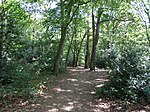Mousehold Heath is a freely accessible area of heathland and woodland which lies to the north-east of the medieval city boundary of Norwich, in eastern England.
The name also refers to the much larger area of open heath that once extended from Norwich almost to the Broads, and which was kept free of trees by both human activity and the action of animals grazing on saplings. This landscape was transformed by enclosure during the nineteenth century and has now largely disappeared, as almost all of it has since been converted into farmland or landscaped parks, reverted to woodland, or has been absorbed by the rapid expansion of Norwich and its surrounding villages, where new roads, shops, houses and industrial units have been built. The present Mousehold Heath consists of mostly broad-leaf woodland, with isolated areas of heath that are actively managed. It is home to a number of rare insects, birds and other vertebrates.
A chapel dedicated to William of Norwich (a local child who was murdered in 1144) was erected on the heath, of which little remains today. In 1549, Robert Kett camped on the heath with his followers, days before their uprising was suppressed by the authorities. The heath was in the past used by the local population to collect fuel, food and housing materials, as well as to extract sand, clay and gravel. Parts of it have previously been used as a cavalry training ground, a race course, a United States Army Air Forces base, an aerodrome and a prisoner-of-war camp. Nowadays the last remnant of the original Mousehold Heath, managed by Norwich City Council, is surrounded on all sides by housing and light industry.









